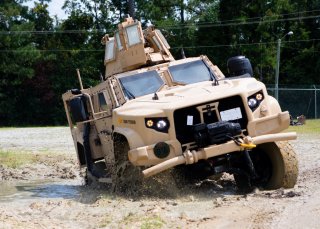The Joint Light Tactical Vehicle Moves Closer to the Chopping Block
Though the new vehicle will replace the Humvee, the Department of Defense might purchase fewer than originally planned.
The Congressional Research Service, a non-partisan think-tank that informs Congress’ decision-making process, released a report on the Joint Light Tactical Vehicle (JLTV) that covered the Humvee replacement’s status and what the JLTV’s future will be. Here is what the report revealed.
The Joint Light Tactical Vehicle replaced the Humvee and is already in service across multiple Department of Defense branches.
“The Army’s current modernization strategy is primarily focused on six modernization priorities that do not include the JLTV,” the report explains. “Furthermore, the Army announced in January 2022 that under the Army 2030 Force Design Initiative, the Army would either redesignate existing divisions or create new divisions into five new types of divisions.”
These five new types include Standard Light, Standard Heavy, Penetration, Joint Force Entry Air Assault, and Joint Force Entry Airborne.
“The Army also announced in May 2022 that it would create a new Alaska-based division, the 11th Airborne Division, by activating new units and reconfiguring two Alaska-based Infantry Brigade Combat Teams (IBCTs). With the creation of new division types and an additional division in Alaska, it is possible that the Army’s requirement for JLTVs could change significantly.”
As a part of the commandant of the Marine Corps’ Force Design 2030 vision, the Marine Corps is moving from a large, land-based force optimized for the kinds of grinding, long-term campaigns that defined the United States’ involvement in the Middle East to its roots as a maritime force.
As a part of that change, the Marine Corps is returning to its amphibious heritage and divesting platforms that would not survive in a littoral environment. To that end, the Corps has divested all its tank battalions, as well as much of its artillery and tube mortar capabilities. The Joint Light Tactical Vehicle could be next.
“With the Marine Corps downsizing in accordance with its March 2020 Force Design Initiative and adoption of a more expeditionary posture (possibly requiring fewer JLTVs), original JLTV procurement plans for both the Army and Marine Corps might no longer be accurate.
“Despite the Army’s intent to lower costs by competing a follow-on contract with another vendor by FY2022, slowing production rates and extended procurement timelines could act to increase costs if current JLTV requirements are no longer valid. In addition, different versions of the JLTV produced by another vendor could result in additional operations and maintenance costs that can result from a mixed fleet of vehicles. Taken collectively, these issues might merit DOD and policymakers examining the future of JLTV procurement to help determine the current requirement for JLTVs and associated cost implications.”
Caleb Larson is a multimedia journalist and defense writer with the National Interest. A graduate of UCLA, he also holds a Master of Public Policy and lives in Berlin. He covers the intersection of conflict, security, and technology, focusing on American foreign policy, European security, and German society for both print and radio. Follow him on Twitter @calebmlarson.
Image: DVIDS.

